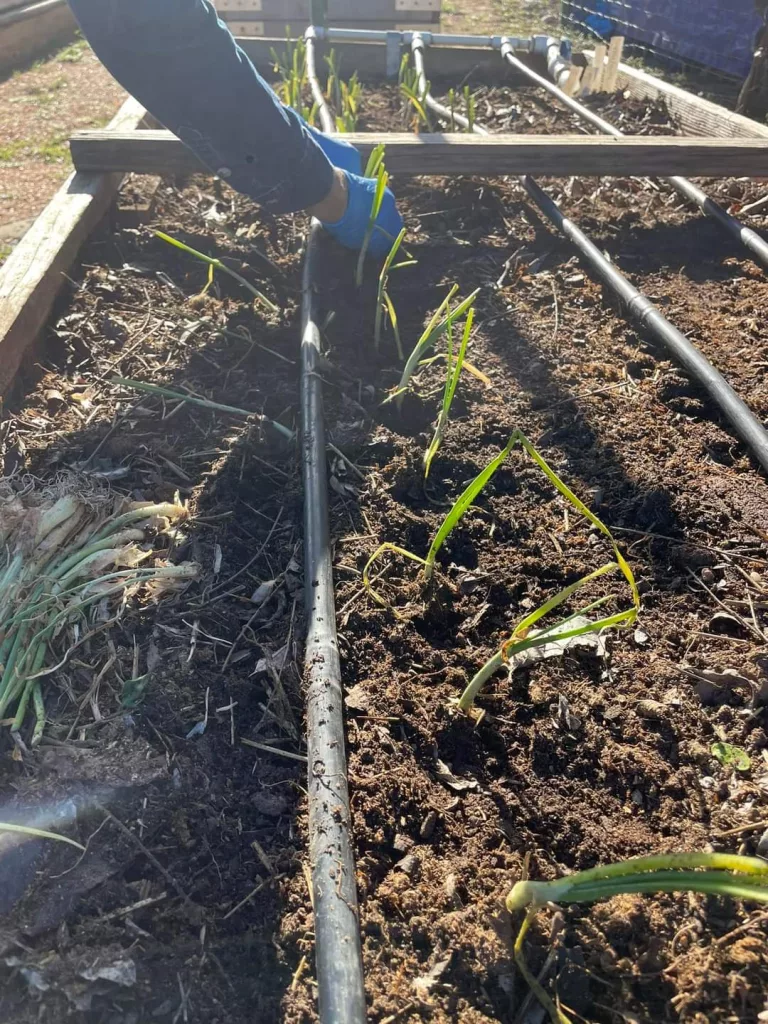
January, a time for resolutions and new beginnings. Where December was largely a time spent celebrating the season and spending time with personal activities, January finds us off to the races.
The asparagus needed to be cut down and fertilized in preparation for the harvest that’s not far off. We’re keeping a watchful eye on the strawberries, although we know it will be some time before we sink our teeth into those tasty treats. Currently, our irrigation system is down, so an occasional watering has become necessary. We’re grateful that we have had occasional periods of rain to lessen that chore. Removal of our pear tree was a several day process completed by one of our faithful gardener/ volunteers. No sooner was that completed when it was replaced with two plum trees. January is also the month we plant our first really big crop-onions. Sweet red onions, Texas legend onions, and Granex (similar to Vidalias) well over 1000 onions which, if cured properly, can actually last for months. Plant in January, harvest in May, and you may still be eating fresh, homegrown onions at Christmas.
Around the middle of the month, a cold front roared in, keeping us out of the garden and bundled up someplace warmer, a perfect time to get that computer out and drool over all those online seed catalogs offering more than one can even begin to imagine. Decisions, decisions, decisions, but alas choices had to be made. This year we will be growing four types of okra, three which are new to us. We’ll be going back to mostly Celebrity tomatoes which have been our best producers- Celebrity Supreme to be exact. Once again we’re trying a couple different types of peppers while sticking largely to the varieties we’ve grown in the past and have proven themselves worthy. Squash is always a challenge for us with the squash bugs, but that doesn’t mean we’ll quit trying-Early Prolific, Lemon Squash, Tatume (similar to zucchini), and a new addition this year, Tromboncino squash. That one is a bit unique in that it can be eaten as a summer squash or allowed to mature into a winter type squash, similar to butternut. We can’t forget those cucumbers. We’ll start off with some burpless cucumbers that are resistant to cucumber beetles (another challenge for us), and then as the summer begins to heat up, we will transition to a heat resistant variety, our garden hero last year- Armenian. We can’t resist trying a new variety there as well, the Indian Snake cucumber which supposedly is even larger and sweeter than the Armenian. We’ll see if we have a new garden hero this year. With all the hundreds of choices, it’s kind of like being a kid in a candy store – for me, a chocolate candy store.
Finally, we are preparing for battle once again. We know we have areas with root knot nematode, and this is something we have to deal with each year. There are multiple strategies we use to help control them so we can still have a productive harvest. Among the strategies we have used in the past are the following: rotating from nematode susceptible crops to nematode resistant crops whenever possible, adding chitin in the form of crab or shrimp meal, planting cereal rye, adding compost and manure to improve the health of the soil, and solarizing the soil if needed. This year we plan on stepping it up a notch by releasing beneficial nematodes into the soil at least twice. This type of nematode will also help control cucumber beetles, fire ants, and a few other garden pests that we typically deal with. Neem oil and worm castings soil drenches are on our “to do” list as well. We are determined to do everything we can to fight the enemy. Hit him early, hit him hard, hit him often. Behind the scenes, plans are being made to replace ten more garden beds, a challenging but much needed task.
So, as the month ended with some absolutely gorgeous days, we saw many of our gardening friends returning to the Garden to plant their onions. We may not have seen them for a couple months, and it’s like old times. We don’t always accomplish all we had hoped to in our garden that day, but the trade off is worth it. I’m reminded that this Garden is not only about the produce. It’s so much more. It’s about learning and sharing ideas and the friendships that have been made right here at Brownwood Community Garden.